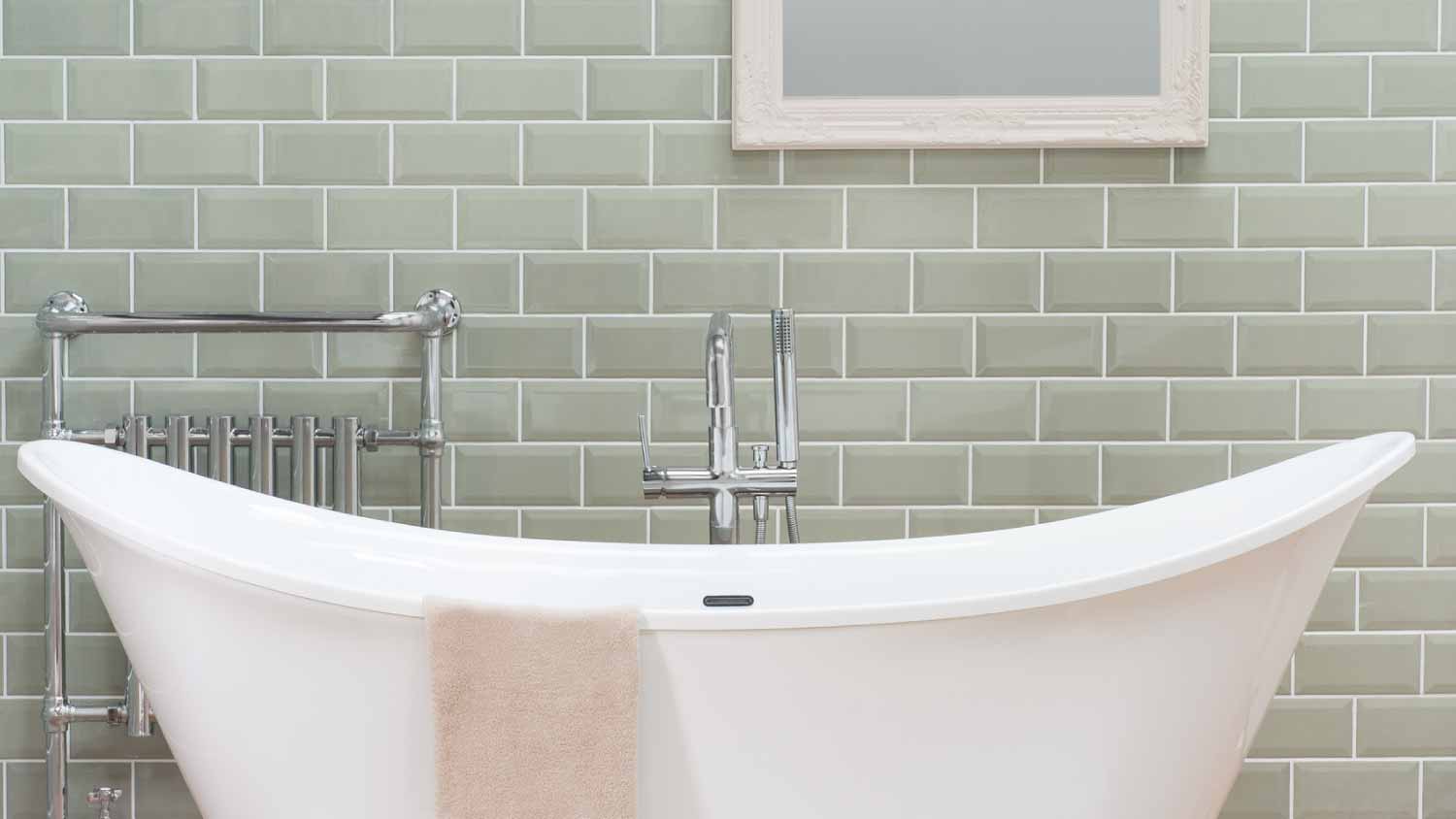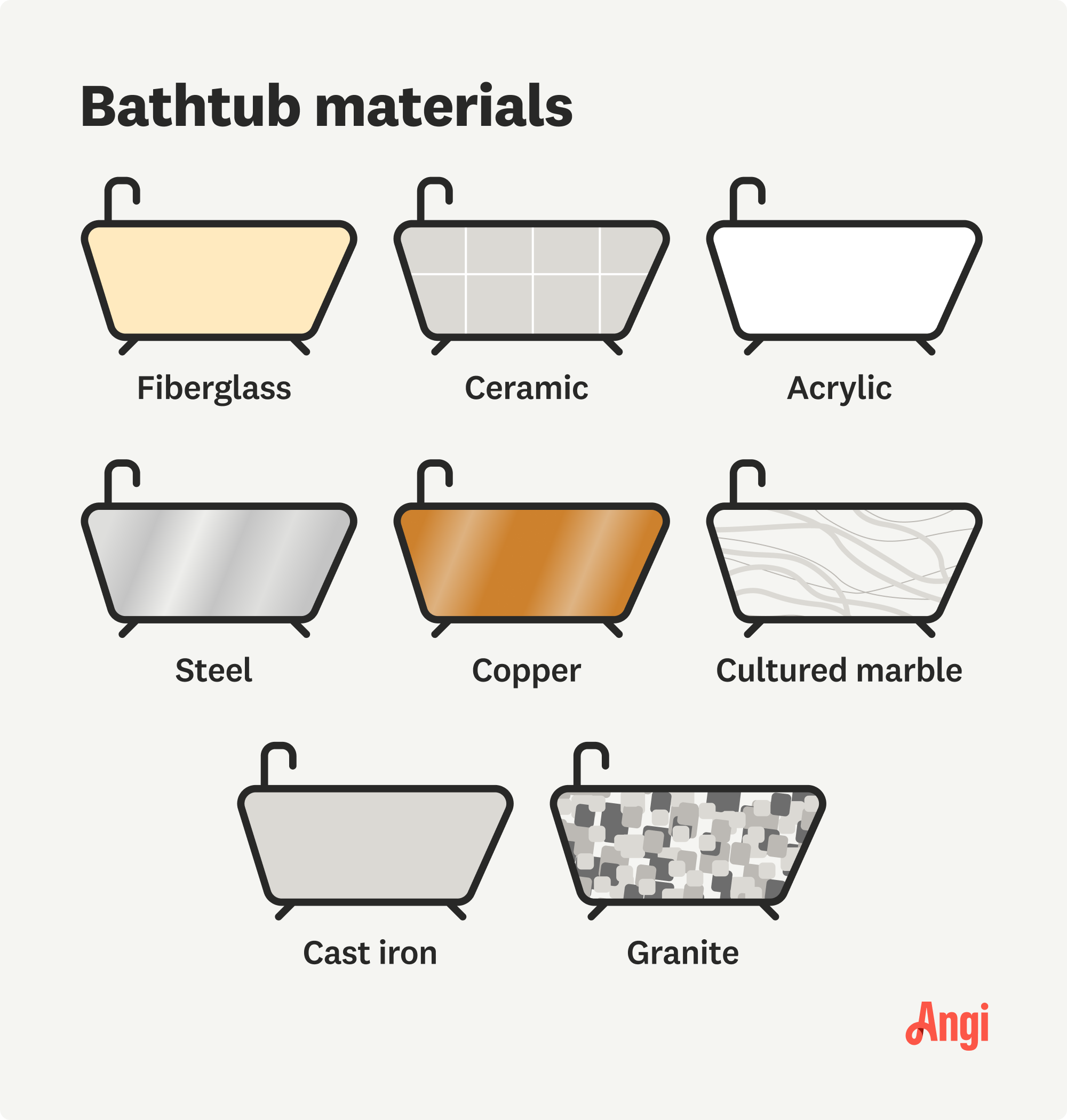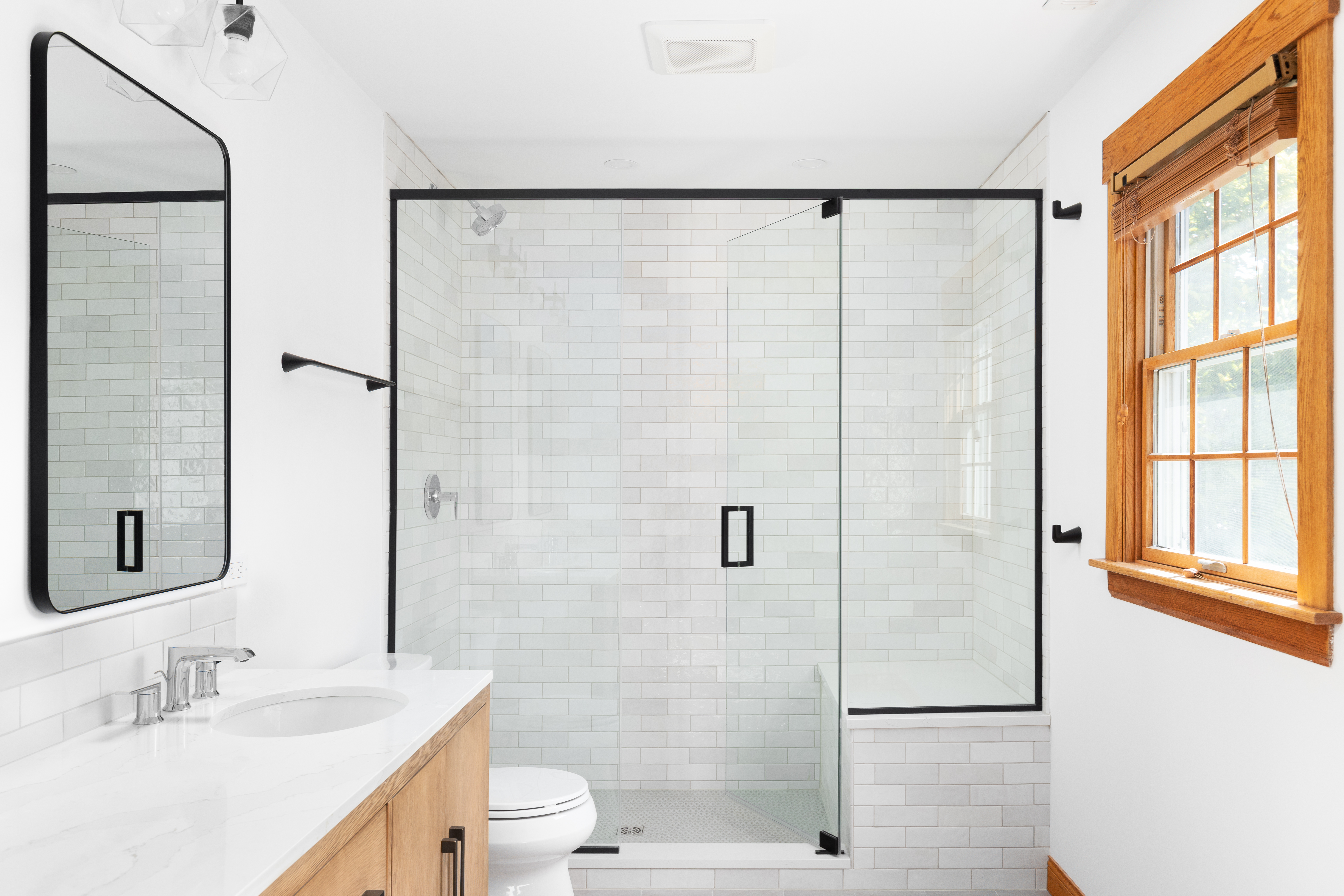
If your bathroom vanity top is damaged or cracked, removing and installing a new one can be an easy project to tackle. Learn the cost of replacing your vanity top.
Replacing a bathtub in Phoenix, AZ, costs an average of $624 to $1,509, depending on the materials you choose. A bathtub installation pro can provide a quote for your specific project.


The labor component for a simple bathtub replacement in Phoenix costs anywhere from $400 to $1,900, depending on project complexity.
Expect to pay $50 to $500 for plumbing and electrical permits, more if structural changes are needed.
Removing and disposing of old tubs costs $50 to $300 or more, with heavier cast iron tubs at the higher end of this range.
Installing a tub surround adds $500 to $2,000 to your overall bathtub replacement cost estimate.
Replacing a bathtub in Phoenix, Arizona costs $1,045 on average, with most projects falling between $624 and $1,509. The final price depends primarily on your tub selection, material choice, and labor requirements. The Valley’s competitive remodeling market and skilled labor pool mean you'll find experienced contractors, though plumber and electrician rates reflect the area's growing demand for bathroom upgrades.
Material choice tops the list among driving factors that influence what you’ll pay to replace a bathtub in Phoenix, Arizona. The extreme heat of this desert region makes acrylic and copper materials particularly valuable, as both retain coolness and withstand temperature fluctuations better than many alternatives.
Many tub styles balance aesthetics and utility to bring comfort and relaxation. Here’s a look at the average prices for different bathtub types:
| Tub Style | Average Cost |
|---|---|
| Standard | $200–$2,000 |
| Soaking tub | $600–$13,000 |
| Jet and Whirlpool | $1,000–$4,000 |
| Freestanding | $2,000–$3,000 |
| Walk-in | $4,000–$22,100 |
| Accessible | $4,000–$12,000 |
| Clawfoot | $10,000+ |
A standard bathtub is one of the least expensive options, with costs ranging from $200 to $2,000, depending on the tub material. General-purpose tubs are rectangular or oval-shaped and have a showerhead above. You may also need to install a surround for an additional $500 to $2,000.
Deep-basin soaking tub costs range from $600 to $13,000. Like other styles, the price of soaking tubs is mainly determined by material and size. Because these are deeper than standard tubs, confirm that the tub will fit your space before purchasing.
Bathtubs with jets help soothe stiff muscles and sore joints. The average Whirlpool-style tub costs $1,000 to $4,000, and these come in a variety of shapes and sizes to fit your needs. Jets require electricity, so additional work is required to install these tubs, which means higher labor costs and possibly a more substantial remodel.
Freestanding bathtubs have space to move around on all sides. They make for a distinctive element to your bathroom, especially if you’re accustomed to traditional built-in tubs. Freestanding tubs average $2,500, but ensure you have enough space before committing.
Walk-in tubs offer safety and comfort features, including a door, and allow for easier access for older adults and people with disabilities. They cost between $4,000 and $22,100 and can increase your home’s value.
While walk-in tubs offer one form of accessibility, accessible bathtubs can offer more features (including walk or slide-in functions). Most accessible bathtubs are larger and may include a wider, sometimes motorized, entryway. The cost of accessible bathtubs ranges from $4,000 to $12,000.
Distinctive clawfoot tubs can cost $10,000 or more, but you can find options that fit just about any price range. Depending on the material used, the job may require flooring reinforcement.

The bathtub material you choose is a major factor in how much it costs to replace a bathtub.
| Material | Average Cost | Pros | Cons |
|---|---|---|---|
| Fiberglass | $200–$800 | Lightweight; affordable | Doesn’t retain heat |
| Ceramic | $5,000–$10,000 | Unique design | Can chip |
| Acrylic | $700–$1,000 | Lightweight; durable | Discoloration |
| Steel | $200–$1,000 | Lighter than cast iron | Loud; can chip |
| Copper | $2,000–$5,000 | Durable; mold-resistant | More costly |
| Cultured marble | $2,000–$5,000 | Stylish | Heavy; can crack |
| Cast iron | $400–$14,000 | Durable | Heavy |
| Granite | $10,000–$20,000 | Aesthetic | Heavy; difficult to install |
Fiberglass tubs are an affordable option. They’re lightweight and come in a variety of colors. You'll pay between $200 and $800 to install a new fiberglass bathtub. Unlike some other materials, fiberglass is not great at retaining heat.
Adding a ceramic tub to your bathroom costs anywhere from $5,000 to $10,000, with prices varying based on the colors and styles of ceramic tile you choose. Ceramic tubs offer unique bathtub design choices, but you will have to clean the grout and repair chips.
Acrylic is a popular material for Phoenix residents thanks to its ability to withstand big temperature swings at a reasonably affordable price. Standard acrylic tubs cost $700 to $1,000, with high-end models approaching $14,000. Opt for acrylic for a lightweight, durable bathtub option.
Enameled steel is a lighter and more cost-efficient alternative to cast iron, with a price range of $200 to $1,000. However, steel drawbacks include the risk of chipping, and they can make a cacophony of sounds while filling.
Copper bathtubs cost $2,000 to $5,000. In addition to its chic appearance, copper is a durable, long-lasting material that’s resistant to mold and bacteria. It stays cool during hot desert summers, but copper also holds heat well, making it ideal for long, hot baths.
Stylish marble makes for a show-stopping bathroom. Installing a marble tub will run between $2,000 and $5,000. Unlike acrylic, marble is heavy and susceptible to cracks. Ask your pro about extra care and reinforced flooring when you opt for marble.
Porcelain enamel-coated cast-iron tubs come in a range of styles to fit your dream bathroom. They retain heat well, but cast iron is heavy and may require extra reinforcements. Cast-iron bathtubs cost between $400 and $14,000.
The best part of a cast iron tub is the lack of noise and high rigidity. There’s no flex or anything like that.
If you want a bathtub that doubles as modern decor, you can install a granite tub for $10,000 to $20,000. This material is incredibly durable and long-lasting, but can be heavy and difficult to install.
Removing the old tub and inserting the new one isn’t always as easy as it sounds, and there are plenty of additional costs.
| Additional Projects | Average Cost |
|---|---|
| Tub removal and disposal | $50–$300+ |
| Shower-to-tub conversion | $2,000–$10,500 |
| Subfloor prep and reinforcement | $300–$800 |
| Surround | $500–$2,000 |
| Bath liner | $2,700–$10,000 |
| Faucets | $50–$900 |
| Electrical upgrades | $1,600 |
| Water damage repairs | $450–$14,000 |
The cost to remove and dispose of an old bathtub depends on its type. Fiberglass tubs, which are lighter in weight, cost $50 to $100 to remove. Hauling away a heavy cast-iron bathtub could cost $300 or more.
Converting a shower into a bathtub costs $2,000 to $10,500, similar to typical tub-to-shower conversion cost estimates. You’ll need to remove the shower—and since tubs are larger than showers—you might have to remove walls, relocate plumbing, or move electrical wiring to make room for a tub.
Heavy tubs need structural support underneath, which can cost $300 to $800. Repairing floor joists costs $4,000 to over $12,000, depending on the condition of the existing floor joists. The cost of subfloor replacement due to damage under your old tub is $3 to $10 per square foot, but your bathroom remodeling project may not require it.
Installing a bathtub surround costs $500 to $2,000. For bathtub-shower combos, you’ll want to install a surround consisting of waterproof panels to protect the drywall from shower water.
Bath liners cost $6,400 on average, but they range from $2,700 to over $10,000, depending on the size of your existing tub. A bath liner is a customized acrylic layer that fits over an existing tub to give it a new look and feel.
Adding a new faucet or other bathtub hardware costs an average of $50 for basic options to over $900 for hardware made from copper or porcelain. You can spend over $700 for high-end faucets, like waterfall or spa-style faucets.
Upgrades to an electrical panel cost $1,600 on average. You may also need to upgrade or add electrical wiring to your bathroom. This may be necessary if you install a jetted or Whirlpool-style bathtub or a tub with high-tech features, like lighting or speakers. If you’re adding a jetted tub, you’ll need a ground fault circuit interrupter (GFCI), which costs an average of $210 to install.
When you take out the old tub or shower, you may encounter water damage in the floors or walls. Addressing water damage may mean adding the cost to demo a bathroom to your bathtub replacement project. Water damage restoration costs an average of $3,850. Smaller cases cost as little as $450, while extensive damage and repairs can cost over $14,000.
You may choose to refinish or replace a bathtub, depending on its condition. Refinishing involves sanding the tub and coating it with primer and paint to remove any small dents or scratches and give it a clean and fresh appearance. Bathroom contractors can complete the refinishing process in a day, and it costs $300 to $700.
If your bathtub is severely damaged or has major leak issues, it might not be in good enough shape to refinish, making bathtub replacement a better option. If leaks have damaged the flooring or surrounding wall, you’ll need to make repairs and remove mold.
Depending on the new tub, you might need to reroute plumbing to make the bathtub replacement work. In determining who to hire for a bathroom remodel, you may need to call both a plumber and an electrician.
Phoenix's growing metro area creates a competitive market for bathroom contractors, which influences both pricing and availability. Labor rates here reflect the practical challenges of working in extreme heat during the summer months.
The labor cost to replace a bathtub is $400 to $1,900, with Phoenix bathtub installers charging $40 to $120 per hour. Most bathtub replacements require three to six hours of labor for straightforward installations. Costs go higher if you relocate plumbing lines, remove or install a heavy bathtub, or make repairs to subflooring.
If you’re installing a different type of tub than the existing one or placing the new one in a different spot, you might need some plumbing work. Budget $400 to $1,900 to move plumbing lines and pipes.
The City of Phoenix requires permits for bathroom renovations involving plumbing or electrical work. Building permits cost $50 to $500 for plumbing and electrical work, based on your project's total valuation. Your contractor should handle permit applications and ensure all work meets current Phoenix building codes. Don’t start work until you secure them, even if you’re DIYing, as unpermitted work can derail real estate transactions.
Phoenix's intense heat affects comfort, material performance, and installation timing. Acrylic and copper resist thermal expansion issues that can plague other materials. Your contractor may recommend specific installation techniques to account for the dry air and temperature extremes that characterize desert living.
Many contractors prefer working early mornings during June through August when temperatures regularly exceed 110°F. Some professionals charge premium rates for summer work or may schedule projects during cooler months when indoor conditions are more manageable.
A midrange update can recoup 50% to 80% of the bathroom remodel cost at resale in and around Phoenix. This is typically the case with a bathtub replacement that’s accompanied by other upgrades or cosmetic changes, like new fixtures, to improve the appeal of the bathroom. A tub replacement on its own trends toward the lower end of this range.
In Phoenix's competitive real estate market, updated bathrooms appeal strongly to buyers who prioritize move-in-ready homes with modern amenities. With a significant population of retirees, accessibility features are particularly valuable among would-be homebuyers. Installing walk-in tubs or replacing standard tubs with accessible options addresses both current needs and future resale potential.
For maximum return on investment (ROI), focus on mid-range materials and timeless designs rather than ultra-luxury options. Phoenix buyers value functional updates and low-maintenance features that suit the desert environment.
Home is the most important place on earth, which is why Angi has helped more than 150 million homeowners transform their houses into homes they adore. To help homeowners with their next project, Angi provides readers with the most accurate cost data and upholds strict editorial standards. We survey real Angi customers about their project costs to develop the pricing data you see, so you can make the best decisions for you and your home. We pair this data with research from reputable sources, including the U.S. Bureau of Labor Statistics, academic journals, market studies, and interviews with industry experts—all to ensure our prices reflect real-world projects.
Want to help us improve our cost data? Send us a recent project quote to [email protected]. Quotes and personal information will not be shared publicly.
From average costs to expert advice, get all the answers you need to get your job done.

If your bathroom vanity top is damaged or cracked, removing and installing a new one can be an easy project to tackle. Learn the cost of replacing your vanity top.

Remodeling your bathroom can add significant value to your home. Your bathroom remodel cost in Columbus, OH will depend on size, fixtures, materials, labor, and other factors.

The cost to add a half bathroom varies based on geography and your choice of additions. Read on to discover just what factors into your total project cost.

Understanding the types of kitchen remodel work that require a permit and how to apply for one will help you avoid any complications or fines further down the line. Read this guide to understand all the important steps.

If your shower door has been acting up, it’s time to get it back in working order. You can adjust a shower door with some common adjustments.

What are a few black stainless steel sink pros and cons? It's an eye-catching sink style, but it's only right for some kitchens.